More about Thimbles





AT - an elusive Russian thimble maker’s mark
Navigation
Magdalena and William Isbister
Recently we won an ‘Antiker russischer Fingerhut in 875er Silber’ on Ebay. It was supposed to have been made by ‘Yakov Lyapimov’ of Saint Petersburg.
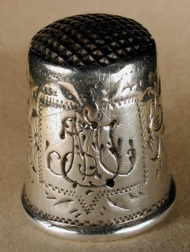
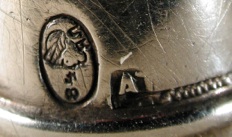
The thimble had a waffle dimpled steel top and a bright cut floral cartouche with some indecipherable characters. On the reverse side was a crudely engraved cross, a heart and some other object. The rim was plain, round and turned over. When we were able to examine the thimble more carefully we discovered that Yakov Lyapimov (ИЛ) was the assayer and that the maker’s mark was AT. Yakov Lyapimov worked in Saint Petersburg between 1899 and 1903, but who was ‘AT’.
AT could be the mark of several goldsmiths working in Saint Petersburg when the thimble was assayed; Alfred Thielemann, a Fabergé workmaster, Alexander Theodore Tillander, his father Alexander Edward, A. Tobinkoff, a silversmith with the firm Nickols and Plincke, and an A. Treiden (K. Hahn’s workmaster).
Alfred Thielemann, the Fabergé workmaster, produced a significant proportion of Fabergé’s presentation jewels. He used the mark AT, but it appears that he would not have made simple silver thimbles or finger guards.
A silver finger guard has been recorded (1), with the mark AT. The guard was attributed to Alexander Theodore Tillander and he seemed to be the most likely maker of our thimble too and so we sought more information regarding the Tillander family.
Alexander Edward Tillander was born in 1837 to a family of poor farmers near Helsinki. When he was only 11, he was sent to live with his brother in Saint Petersburg in order to learn a trade as a barber. The young Tillander was not interested in becoming a barber and returned to Helsinki. He was apprenticed to the Finnish master goldsmith, Frederik Adolf Holstenius. Upon completion of his time as an apprentice he became a journeyman and returned to Saint Petersburg where he worked for the German master Carl Becks, maker of Imperial orders and decorations. In 1860, Alexander Tillander became a master and opened his own small shop where he produced simple gold bangles which sold easily. The business gradually expanded and he began taking apprentices and even a journeyman of his own (‘A. Tillander Co.’). He concentrated on making fashionable, well-designed, simple items which were inexpensive and popular.
Tillander married a girl from his native Finland with whom he had a son, Alexander Theodor in 1870. The business was renamed ‘A. Tillander Jewellers’ (Jalokivisepänliike A. Tillander). The quality of the workmanship continued to improve and he was recognized with the award of silver medals at the Saint Petersburg and Ekaterinburg arts and crafts shows. He was commissioned to make decorative objects in gold, silver and hard stone with enamel decoration in the style made famous by Fabergé.
In 1885, Alexander Theodor was apprenticed to his father. There followed time spent with Smets & Fournier in Paris, Gugenheim and White in London and Kämpffs in Dresden before he returned home in 1891 as the representative of L. Coulard, the Parisian diamond jewellery manufacturer.
Alexander Theodor then joined his father’s company and introduced an agency for the export of garnets from the Urals and a commission that traded in privately owned second-hand jewellery and objects d’art. By the end of the nineteenth century he was in control of the business and by this time his customers included: the Grand Duke Vladimir and Alexis, the Grand Duchess Marie Pavlovna, and the Grand Dukes Andere and Boris.
In 1899, Alexander Theodor married a Finnish girl and they had three sons, Leo, Herbert and Viktor. Between 1907 and 1909 the company enjoyed the patronage of Marie Feodorovna, the Tsar and Tsarina, the Tsar’s sister the Grand Duchess Olga as well as members of the cabinet, bankers, and other wealthy patrons.
In 1917, the Russian Revolution resulted in the closure of the business. Alexander Edward was the target of an attempted robbery in front of his shop in Nevsky Prospekt. During the melee he was shot in the head and died in Saint Petersburg the following year. In 1921, ‘Alexander Tillander Jewellers’ re-opened in Helsinki, Alexander’s sons Leo, Herbert and Viktor joined the business and between 1923 and 1957, the head designer was Oskar Phil (son of Fabergé’s Moscow master).
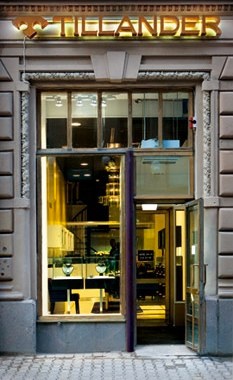
In 1943, Alexander Theodor died and was succeeded as Director of the company by Herbert. In 1963 Ulla, Herbert’s daughter moved to London to open a Tillander shop and later she managed the entire company. In the eighties, Herbert and his daughter sold the business and the ‘Tillander’ name and presently the company, now called ‘1860 A. Tillander’, is owned by Golden Heighjts Oy.
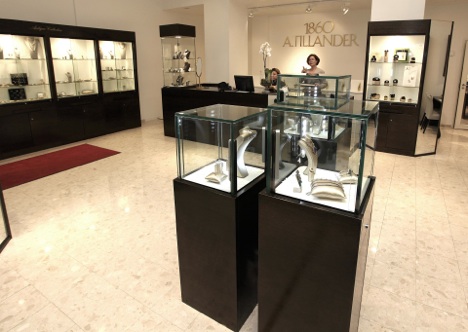
In 1946 Leo’s son, Torbjörn who planned to become an engineer, was offered the opportunity to become an apprentice in the ‘Tillander’ workshop and thus he became the fourth generation ‘Tillander’ to become a goldsmith. He worked for ‘Atelier Tillander’, first as a goldsmith and then as a partner and manager. He became friends with Oskar Pihl who had a great influence on how Torbjörn interpreted the art of jewellery.
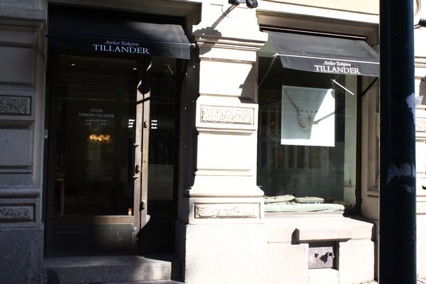
Torbjörn founded his own business, ‘Atelier Torbjörn Tillander’, in 1956 and designed jewellery for the Finnish company Kalevala Koru. Then in 1960 he founded his own jewellery factory on Kalevankatu in Helsinki. Three years later he met his wife, Paula, who also joined the business. Together they had two daughters, Annette and Tina, both of whom became involved in the family business as teenagers. In 1980 the elder daughter Annette became an apprentice to her father and four years later the younger daughter, Tina, graduated as a goldsmith. In 2008 Tina Tillander was appointed the company’s managing director while Annette left the company to found her own company. ‘Annette Tillander’.
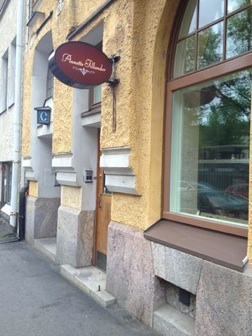
Tillanders have thus been goldsmiths since 1860 and are now in their fifth generation. During this period their maker’s marks have changed. Alexander Edward and Alexander Theodor’s marks were AT in a rounded oblong, Torbjörn’s mark was TT in a rounded oblong and Annette’s mark is ATT in a rounded oblong.
Although the Saint Petersburg Tillanders were famous for their items that were produced in the style of Fabergé, it seemed probable that in Alexander Theodor’s early days he would probably have made smaller and simpler items. We have been assured, however, that since our thimble is not worked in the Tillander style (personal communication: Ulla Tillander-Godenhielm), the AT on our thimble could not represent a Tillander workmaster’s mark.
Treiden has also been eliminated as a possible maker of our thimble because he would never have had time to make small objects such as thimbles (personal communication: Ulla Tillander-Godenhielm).
A. Tobinkoff thus becomes the most likely maker of our thimble. He is said to have used both the marks A.T and AT (2, 3). There seems to be no ‘dot’ to be seen between the A and the T on our thimble but the lower part of the mark is obscured. Whether this is important or not is uncertain.
We also think that the previously identified silver finger guard (1) which was attributed to Tillander should now be re-attributed to A. Tobinkoff. It is clearly marked A.T inside an oval, with 84 and the Saint Petersburg town mark.
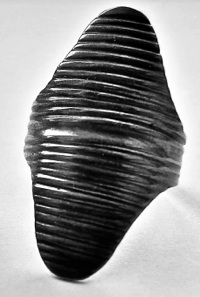

Tobinkoff was a master silversmith who worked for the company of Nickols and Plincke. Nickols and Plincke had an art gallery in Saint Petersburg in the nineteenth century and later they became known as silversmiths.
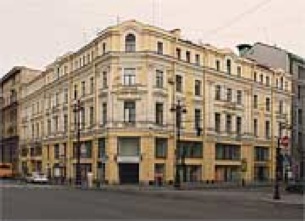
Their shop was at 16, Nevsky Prospekt, a building on the northern corner of Nevsky Prospekt and Bolshaia Morskaya. It was a late 19 century reincarnation of a large mansion. It first belonged to General Illarion Ovtsyn and was originally built in 1766 by architect Andrei Kvasov. Twenty years later, John Pickersgill, a merchant opened an Anglyiskii magazin (or English shop) at this address and in 1815 the shop was sold to Constantine Nichols and William Plincke (both Russian citizens despite their English names). Alexander Pushkin patronized the establishment. In 1844, Robert Cohen, joined the business. Russian made silverware, branded by Magazin Anglais of Nichols and Plincke, especially pieces made before 1860s, are quite valuable. Their maker’s mark is N & P.
What of the present day Tillanders and thimbles? This gold thimble with inset pearls and rubies and engraved leaves was designed by Annette Tillander and made in 2003 by Atelier Torbjörn Tillander. The goldsmith was Valtteri Lonka. It is marked around the rim.
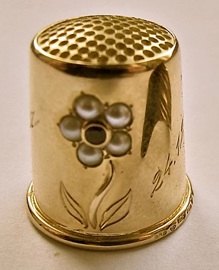
More recently Annette Tillander designed a gold thimble with engraved flowers and inset sapphires, garnets and diamonds. It is marked ATT, L9 and 750 in the top and ‘Design Annette Tillander Finland’ inside the rim.
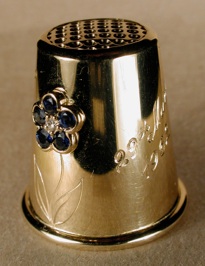
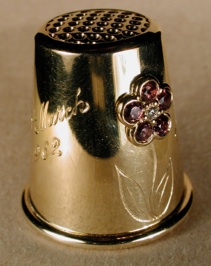
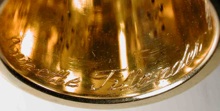
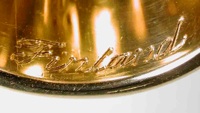
This thimble was made by the goldsmith Jan-Erik Heino.
In this paper we have sought to discover the maker of our silver thimble. We have described five generations of Tillander goldsmiths and identified, what we consider to be the only known thimbles made by this family, throughout their working period. We have found another silversmith who was working in Saint Petersburg at the same time as the early Tillanders and we think that our silver thimble and probably the silver finger guard, both of which are marked AT, were made by him, his name was Tobinkoff.
Acknowledgements
We wish to thank Annette Tillander and Martti Helsilä for their valuable contributions in the preparation of this paper, and Dr. Ulla Tillander-Godenhielm for her helpful advice.
References
1. Helsila I and Helsila M. Einige Notizen über russische Fingerhüte. Rund um den Fingerhut, 2000; 32: 15.
2. Slavisches Institut München. Verzeichnis der russiscchen Gold- und Silbermarken. Slaviscches Institut, 1971.
3. von Habsburgh-Lothringen G, von Solodkoff A. Fabergé, Hofjuwelier der Zaren. Office du Livre, Fribourg und Verlag Ernst Wasmuth, Tübingen, 1979.
Marks

Alfred Thielemann


1860-1890 1890-1917
Alexander Edward and Alexander Theodore Tillander


A. Tobinkoff
Holmes: na.
Researched and published in 2002/11
Copyright@2011. All Rights Reserved
Magdalena and William Isbister, Moosbach, Germany
